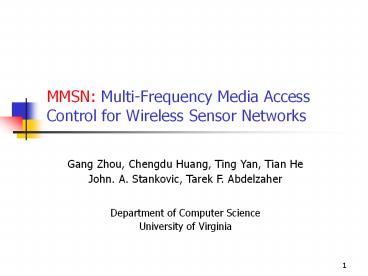MMSN: Multi-Frequency Media Access Control for Wireless Sensor Networks - PowerPoint PPT Presentation
Title:
MMSN: Multi-Frequency Media Access Control for Wireless Sensor Networks
Description:
1. MMSN: Multi-Frequency Media Access Control for Wireless Sensor Networks. Gang Zhou, Chengdu Huang, Ting Yan, Tian He. John. A. Stankovic, Tarek F. Abdelzaher ... – PowerPoint PPT presentation
Number of Views:119
Avg rating:3.0/5.0
Title: MMSN: Multi-Frequency Media Access Control for Wireless Sensor Networks
1
MMSN Multi-Frequency Media Access Control for
Wireless Sensor Networks
- Gang Zhou, Chengdu Huang, Ting Yan, Tian He
- John. A. Stankovic, Tarek F. Abdelzaher
- Department of Computer Science
- University of Virginia
2
Outline
- Motivation
- State of the Art
- Overhead Analysis
- Contribution New Protocol Framework
- Frequency Assignment
- Media Access Design
- Performance Evaluation
- Conclusions
3
Ad Hoc Wireless Sensor Networks
- Sensors
- Actuators
- CPUs/Memory
- Radio
- Minimal capacity
Self-organize
4
Motivation
- Limited single-channel bandwidth in WSN
- 19.2kbps in MICA2, 250kbps in MICAz/Telos
- The bandwidth requirement is increasing
- Support audio/video streams (assisted living, )
5
State of the Art Multi-Channel MAC in MANET
- Require more powerful hardware/multiple
transceivers - Listen to multiple channels simultaneously
- Nasipuri 1999, Wu 2000, Nasipuri 2000,
Caccaco 2002 - Frequent Use of RTS/CTS Controls
- For frequency negotiation
- Due to using 802.11
- Examples Jain 2001, Tzamaloukas 2001,
Fitzek 2003, Li 2003, Bahl 2004, So 2004,
Adya 2004, Raniwala 2005
6
Basic Problems for WSN
- Dont use multiple transceivers
- Cost
- Form factor
- Packet Size
- 30 bytes versus 512 bytes (or larger) in MANET
- RTS/CTS
- Costly overhead
7
RTS/CTS Overhead Analysis
- RTS/CTS are too heavyweight for WSN
- Mainly due to small packet size 3050 bytes in
WSN vs. 512 bytes in MANET - From 802.11 RTS-CTS-DATA-ACK
- From frequency negotiation case study with MMAC
- MMAC
- RTS/CTS frequency negotiation
- 802.11 for data communication
8
Contributions
- A new multi-frequency MAC, specially designed for
WSN - Single half-duplex radio transceiver
- Small packets sizes
- Developed four frequency assignment schemes
- Supports various tradeoffs
- Toggle transmission and toggle snooping
techniques for media access control - An optimal non-uniform backoff algorithm, and a
lightweight approximation
9
Frequency Assignment
Reception Frequency
F8
F7
- Complications
- Not enough frequencies
- Broadcast
F6
F5
F1
F4
F2
F3
10
Frequency Assignment
When frequencies gt nodes within two hops When frequencies lt nodes within two hops
Exclusive Frequency Assignment Implicit-Consensus Even Selection Eavesdropping
Both guarantee that nodes within two hops get different frequencies The left scheme needs smaller frequencies The right one has less communication overhead
Balance available frequencies within two hops The left scheme has fewer potential conflicts The right one has less communication overhead
11
Media Access Design
- Issues
- Packet to Broadcast
- Receive Broadcast
- Send Unicast
- Receive Unicast
- No sending/no receiving
F8
F7
F6
F5
F1
F4
F2
F3
12
Media Access Design
- Different frequencies for unicast reception
- The same frequency for broadcast reception
- Time is divided into slots, each of which
consists of a broadcast contention period and a
transmission period.
13
Media Access Design
Case 1 When a node has no packet to transmit
14
Media Access Design
Case 2 When a node has a broadcast packet to
transmit
15
Media Access Design
Case 3 When a node has a unicast packet to
transmit
16
Toggle Snooping
- During , toggle
snooping is used
17
Toggle Transmission
- When a node has unicast packet to send
- Transmits a preamble
- so that no node sends to me
- so that no node sends to destination
- We let
18
Simulation Configuration
Components Setting
Simulator GloMoSim
Terrain (200m X 200m) Square
Node Number 289 (17x17)
Node Placement Uniform
Payload Size 32 Bytes
Application Many-to-Many/Gossip CBR Streams
Routing Layer GF
MAC Layer CSMA/MMSN
Radio Layer RADIO-ACCNOISE
Radio Bandwidth 250Kbps
Radio Range 20m45m
Confidence Intervals The 90 confidence intervals are shown in each figure
19
Performance with Different Physical
Frequencies- With Light Load
- Performance when delivery ratio gt 93
- Scalable performance improvement
- Overhead observed when frequency is small
- More scalable performance with Gossip than
many-to-many traffic
20
Performance with Different Physical
Frequencies With Higher Load
- When load is heavy, CSMA has 77 delivery ratio,
while MMSN performs much better - MMSN needs less channels to beat CSMA, when the
load is heavier
21
Performance with Different System Load
Observation CSMA has a sharp decrease of packet
delivery ratio, while MMSN does not.
Reason The non-uniform backoff in time-slotted
MMSN is tolerant to system load variation, while
the uniform backoff in CSMA is not.
22
Conclusions
- First multi-frequency MAC, specially designed for
WSN, where single-transceiver devices are used - Explore tradeoffs in frequency assignment
- Design toggle transmission and toggle snooping
- Theoretical analysis of an non-uniform back-off
algorithm - MMSN demonstrated scalable performance in
simulation
23
Thanks to anonymous reviewers for their valuable
comments!
The End!
24
Performance with Different Node Densities
25
Backup Slides Optimal Non-Uniform Backoff
26
Even Selection Frequency Assignment
- Beacon (multiple times) to collect nodes IDs
within two hops - Frequency decision is made sequentially in the
increasing order of nodes IDs - When making a decision, randomly choose one of
the least chosen frequencies (once no unique
ones left) - Notify neighbors of decision
- NOTE Frequency assignment happens once (or a few
times)
27
Back Off Period - Slotted
Backoff into a slot
Transmit at end of a slot
28
Non-Uniform Backoff Motivation an Optimal
Solution
- An optimal distribution is presented in the paper
- Uses recursive computation
- Distribution depends on node density
- A simple approximation is needed
29
Non-uniform Backoff A Simple Approximation































